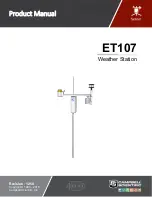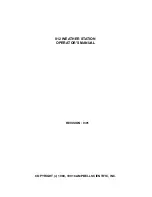
12
Secure battery compartment cover
G. Built-in level with bubble
Ensures level rain gauge mounting for proper operation
H. Bucket see-saw mechanism
Collects the rainfall in one of its containers and self-empties once full
I. Protective screen
Protects the rain gauge funnel from debris
Battery installation
•
Unlock the funnel-shaped top on the rain gauge by turning both knobs on the sides in an
anti-clockwise direction.
•
Remove the funnel-shaped top lifting it off the rain gauge bucket.
•
Remove 7 small screws from the battery compartment cover using a small Phillips
screwdriver
•
Insert 2 “AA” size alkaline batteries (not included), matching the polarities as shown in
the battery compartment.
•
Replace the battery compartment door and secure the screws.
•
Insert the funnel-shaped top into the rain gauge bucket and secure it into place by turning
the knobs clockwise.
Mounting
•
Make sure that the rain gauge bucket is level – check if the bubble center is inside the
built-in leveler.
•
Place the protective screen over the top to protect the rain gauge from the debris.
•
Mount the rain gauge in place using mounting hardware.
•
Make sure that the rain gauge is in open area where precipitation falls directly into the
gauge’s bucket, ideally 2-3 feet above the ground.
Placement
•
The rain gauge should be placed in an open area away from the walls, fences, trees and
other coverings which may reduce the amount of rain falling into the bucket. Additionally,
trees and rooftops may be sources of pollen and debris.
•
To avoid the rain shadow effects, place the rain gauge horizontally, on the distance
corresponding to two to four times the height of any nearby obstruction.
•
It is important that excess rain can flow freely away from the rain gauge.
Operation
After batteries are correctly installed, the rain gauge will start transmitting a rainfall data to the main
unit.
Note: Every time after replacing batteries, press and old DOWN arrow button for 3-4
seconds on the main unit’s control panel or hand held remote control.













































